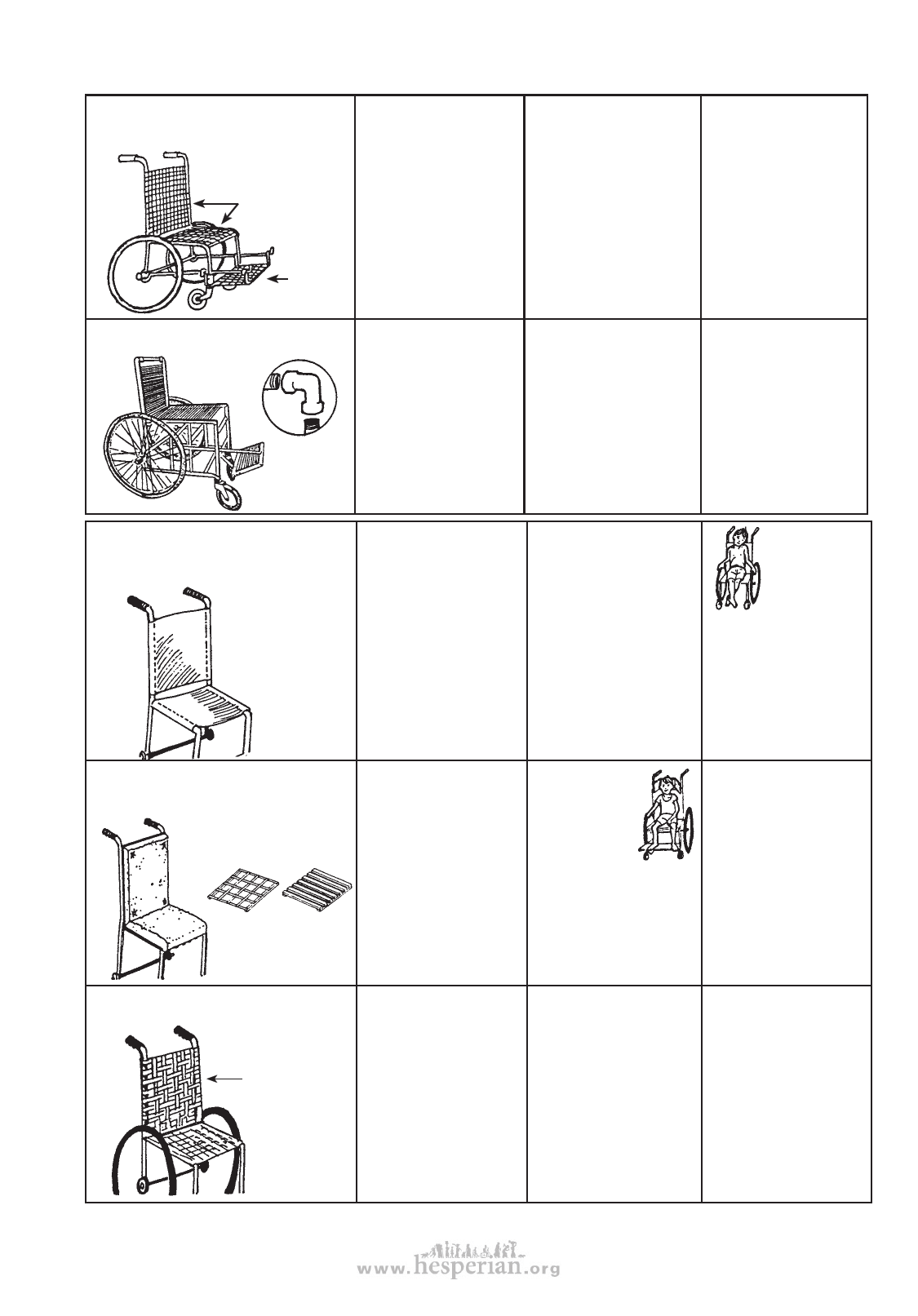
SPECIAL SEATS AND WHEELCHAIRS 595
FEATURE
Re-bar (metal reinforcing rod
used to strengthen cement)
woven plastic
seat and back
DESIGN DETAILS
Design can be the same
as for metal tube chairs,
but it is easier to adapt
because the re-bar is
easy to bend.
footrest
slides in
and out
ADVANTAGES
• relatively cheap
• easier to bend and
weld than steel
tubing
• can have plastic
woven seat and
back (easy to
clean)
• especially good for
small chairs
DISADVANTAGES
• A heavy person or
rough treatment
may bend it out
of shape.
• fairly heavy
PVC pipe (plastic water pipe)
SEATS AND BACKS
Soft canvas or leather
stretched between supports
Firm (but padded)
back and seat
other possibilities
for use under
cushion
metal
slats
wood
slats
Woven seat and back
strips of old
inner tube
stretched tight
• Use 15 mm. PVC
pipe.
• comes with joints
so that it can be
fitted together with
a special glue
• For details see
reference, p. 606.
• lightweight
• can be built mostly
by glueing pieces
together
• For child who is
likely to pee or shit
in the chair, use a
cloth that is easy to
wash.
• Plastic-coated
canvas makes
cleaning easy but is
hot and may irritate
child’s bottom. Best
to use an absorbent
washable pad over it.
• easiest seating and
back design for
folding wheelchairs
• Adjustment to
shape of butt
gives comfort (but
cushion is needed
to protect against
pressure sores).
• Curving back
may help keep
child from falling
sideways.
• Use wood or thin
plywood.
• Special designs
allow a wood seat to
swing up for folding.
• Use natural basket
fibers, reeds, or
rattan,
• or use plastic
webbing,
• or use tightly
stretched strips of
car inner tube.
• Wood seat
and back
allow easy
addition of
supports and
adaptations.
• Firm wood back and
seat help child sit
with back straight
and knees apart
(especially important
for children with
spasticity).
• An open weave
is cooler in hot
weather.
• Plastic or rubber
woven seats can
be easily washed.
Can be used as a
chair to bathe in.
• costly materials
(around $100 US)
• Plastic tubing will in
time sag or bend in
the direction of stress.
Therefore it may
be necessary to
fiberglass the frame—
which adds to cost,
work, and weight.
• Soft, curving
back lets
child bend in
an unhealthy
position (see
p. 591).
• hard to attach
positioning aids
• In children with
spasticity or muscle
imbalance, this may
increase the risk of
developing knock-
knee contractures.
• may be less
comfortable
• without cushion
may cause pressure
sores in child with no
feeling in his butt
• heavier
• difficult or
impossible to fold
the chair
• must be
kept stretched
tight; not useful
on folding
chairs
• may not last
long if material
is not strong
• same sag problems
as with canvas or
leather
disabled village children